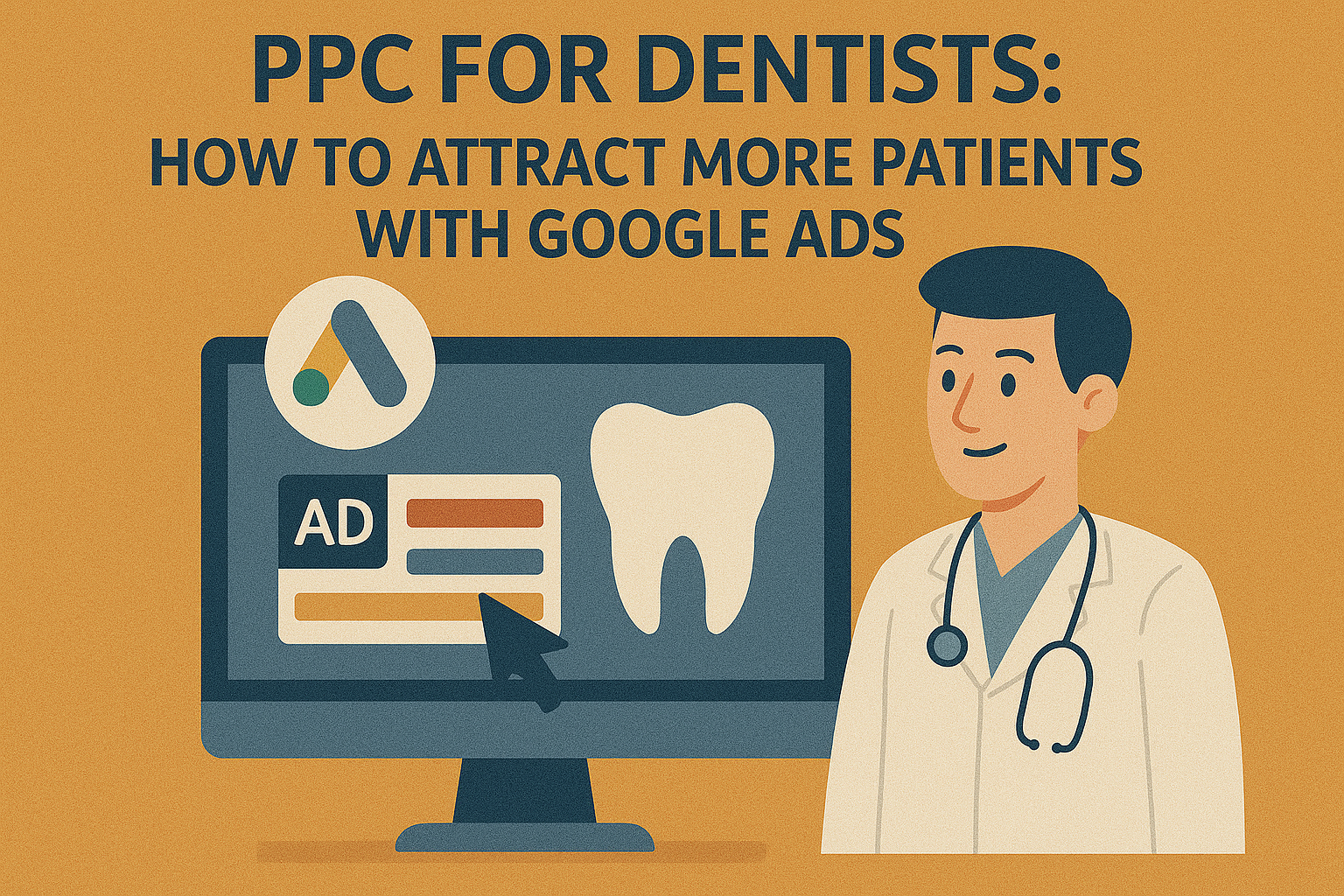In a world where people search “dentist near me” before picking up the phone, Google Ads (PPC) has become one of the most effective ways for dental clinics to instantly attract new patients.
Unlike SEO, which takes time to build momentum, PPC advertising gives you immediate visibility on top of search results, bringing patients to your clinic fast—especially in competitive areas.
In this blog, we’ll explore how PPC for dentists works, why it’s essential in 2025, and exactly how to set up and optimize a campaign that brings real results.
1. Why Google Ads is a Game-Changer for Dentists
Here’s why PPC should be part of every dental practice’s growth strategy:
-
Instant visibility at the top of local search results
-
High-intent leads—people actively looking for dental services
-
Geotargeting to attract patients from your area
-
Full control over budget, targeting, and timing
-
Measurable ROI through call tracking and form submissions
🦷 Example: Someone types “emergency dentist in Houston” — with Google Ads, your clinic can appear above all organic listings, right when they need help.
2. Best PPC Campaign Types for Dentists
There are several types of Google Ads you can run:
a. Search Ads
-
Text-based ads triggered by search queries
-
Appear on top of Google search results
-
Best for attracting new patients searching for services
b. Local Service Ads (LSAs)
-
Google Verified listings with call or booking options
-
Pay per lead (not click)
-
Excellent for urgent dental services or walk-ins
c. Display Ads
-
Visual banner ads across websites, apps, YouTube
-
Best for brand awareness and retargeting past visitors
d. Call-Only Ads
-
Mobile-focused ads prompting users to call directly
-
Ideal for emergency dental services and older audiences
3. High-Converting Keywords for Dental PPC
The success of your ad depends largely on the keywords you bid on. Focus on buyer-intent, location-based phrases.
Top Google Ads Keywords for Dentists:
-
Emergency dentist near me
-
Best dentist in [City]
-
Affordable dental clinic [Location]
-
Pediatric dentist in [Area]
-
Cosmetic dentist near me
-
Root canal specialist [City]
-
Dental implants cost [City]
-
Teeth whitening [Location]
📌 Use Keyword Planner or Ubersuggest to discover search volume, CPC, and competition.
4. Geo-Targeting: Focus Only on Local Prospects
As a dentist, your patients come from a limited geographic area. PPC allows you to laser-focus your ads to reach people only within your clinic’s service radius.
How to Set It:
-
Set location targeting to your city or zip codes
-
Exclude areas where you don’t operate
-
Use location extensions to show your clinic’s address in the ad
💡 Pro Tip: Create separate campaigns for different service areas if your clinic serves multiple locations.
5. Crafting Irresistible Dental Ad Copy
Your ad needs to stand out and compel users to click and call.
Dental PPC Ad Copy Example:
Headline 1: Emergency Dentist in Atlanta – Open Late
Headline 2: Same-Day Appointments Available
Description: Affordable & Trusted Care. Book Now for Exams, Fillings, Cleanings, Whitening & More. Most Insurance Accepted.
📞 Call Now | 🦷 Schedule Online | ⭐ 5-Star Rated
6. Use Ad Extensions for Better Visibility
Google Ads lets you add extensions that expand your ad with more details—leading to higher CTR and more qualified leads.
Key Extensions for Dentists:
-
Call Extensions – Add your phone number
-
Location Extensions – Show clinic address and directions
-
Sitelinks – Link to pages like “Book Appointment,” “Our Services,” or “Meet the Dentist”
-
Structured Snippets – Highlight services: “Teeth Cleaning, Braces, Root Canals”
Adding extensions improves ad rank and provides more info to users before they click.
7. Landing Pages That Convert Visitors Into Patients
Sending ad traffic to your homepage is a mistake. Instead, use dedicated landing pages built to convert.
Must-Haves for Dental PPC Landing Pages:
-
Clear headline: “Book Your Dental Exam Today”
-
Call-to-action buttons: “Call Now” / “Book Online”
-
List of services & benefits
-
Trust signals: Reviews, Certifications, Before-After Photos
-
Mobile-responsive design
-
Quick contact form with minimal fields
Use tools like Unbounce, Instapage, or Leadpages for easy setup and A/B testing.
8. Set a Realistic Budget & Track ROI
PPC is an investment. Even with a modest budget, it can drive high-value patients if optimized correctly.
Suggested Starting Budget:
-
Small practice: $300–$700/month
-
Multi-location clinic: $1,000–$3,000/month
-
Emergency or specialized dentists: $20–$50/day
Track metrics like:
-
CPC (Cost Per Click)
-
CPL (Cost Per Lead)
-
Conversion Rate
-
ROI per service (e.g., implant = high LTV)
Use Google Ads conversion tracking, CallRail, or HubSpot to track phone calls, form fills, and online bookings.
9. Remarketing: Bring Back Interested Visitors
Over 90% of users don’t convert on their first visit. Remarketing ads let you re-engage people who previously visited your website.
Example:
Someone visits your “Dental Implants” page but doesn’t book. Later, they see your ad:
“🦷 Get Your Smile Back – Affordable Implants in [City]. Schedule Now!”
This keeps your clinic top-of-mind and improves conversions.
10. Avoid Common Mistakes in Dental PPC
❌ Bidding on broad keywords like “dentist” without location
❌ Not using negative keywords (e.g., “free dental clinic”)
❌ Ignoring mobile experience
❌ Using a slow or generic website landing page
❌ Not tracking conversions or ROI properly
Fixing these mistakes ensures your ad budget goes toward qualified leads and real appointments.
Conclusion
In 2025, PPC advertising is one of the fastest and most effective ways to grow your dental practice. From emergency services to cosmetic treatments, Google Ads helps you reach high-intent patients exactly when they’re searching.
By targeting the right keywords, writing compelling ads, and optimizing your landing pages, you can fill your appointment calendar consistently—even in a competitive local market.


